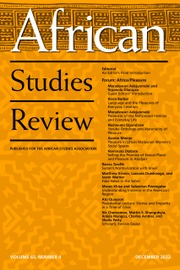In Widow Inheritance and Contested Citizenship in Kenya, Awino Okech examines the practice among Luo communities in Kenya, focusing on its reception among widows and the wider Luo community. Okech argues that widow inheritance, like so many cultural rites that focus on women’s bodies and sexuality, is understood and mobilized in the face of repeated experiences of structural and physical political violence, and other threats to Luo cultural integrity.
The book presents five succinct chapters with an introduction and conclusion, and is based on a case study of a specific set of villages just outside Kisumu city in 2008–09. Okech conducted interviews and focus groups with women who had experienced widow inheritance, as well as men who held roles within the rite, and cultural leaders. The roles of women and the centrality of their bodies in preserving Luo cultural practice and identity in the face of the postcolonial Kenyan national project are explored through an examination and assessment of their performances of culturally appropriate femininity—gendered performances that have the capacity to reinforce and reconstitute Luo identity.
Okech locates her study within African feminist scholarship, rejecting the deficit framing of previous work on widowhood and inheritance. This literature, she argues, has emphasized “the lack of agency of women” (1) and relies on well-worn oppositional binaries including modernity/urbanity, Christianity/African cultural traditions, and rurality/civilization. In contrast, Okech’s work touches on several expansive themes—the origins and contemporary motivations of widow inheritance; gendered citizenship; the limits of international development discourses in supporting Kenyan, and by extension, African woman; and the sexual and reproductive public health implications of widow inheritance.
Chapter One foregrounds the modernity/tradition binary, and the ways in which women’s bodies continue to be sites of contestation where “states and nations continually define and redefine themselves” (10). Here Okech argues that “African culture” was a primary mode of anti-colonial resistance, where the treatment of, and access to women’s bodies were, and continue to be positioned as the antidote to colonial and neocolonial erasure. Chapter Two addresses the heteronormativity at the center of Luo family organization, which requires widow inheritance as an exercise of control over single women. A central thesis of this chapter is that the experience of the HIV/AIDS epidemic has shifted the moral location of widow inheritance, with women who refuse, or negotiate out of inheritance depicted as “modern” and blamed for HIV/AIDS transmission due to assumptions about promiscuity and its association with sex work.
Chapters Three and Four present extensive focus group discussions with widowed women, men, and other community members, who have been directly affected by widow inherence. Okech shows that widow inheritance is understood as policing community boundaries, designating “insiders” and “outsiders” and draws out the complex and, at times, unpredictable uses and transfers of power between men and women. Chapter Five explores both the ways in which language is gendered, as well as the different language strategies that interviewed men and women used to signify authority, power, and control over their own lives, and the life of the community.
Given the author’s position, that “language … [is] the primary means through which we maintain or contest old meanings and construct new ones” (66), a deeper analysis of her own linguistic and translation choices would have been useful here. It is not clear whether the interviews and focus groups were conducted in Dho’Luo and then translated by the author (although I infer this is the case), but she does explain that one of her methodological insights:
concerns the practicalities of working across two different languages (Dho’Luo and English) and the complexities of using discourse analysis in a context where I sought not to represent the narratives through a process of translation but rather to represent them whilst being alert to their “un-translatability.” (4–5)
Although Okech emphasizes the untranslatability of participant’s stories, she generally offers only English quotations, with the occasional Dho’Luo word in translation (43). Where she does offer a more substantial Dho’Luo quotation and then translates it in full (42), the argument is stronger for the bilingualism. Offering this multilingual visibility more extensively in the work would also strengthen her location within postcolonial African feminism, and would have also offered participants the all too rare opportunity to speak and be heard in their own words.
More attention could also have been paid to the temporal and historical context of the field work, especially for readers unfamiliar with recent Kenyan political history. The political violence following the 2007 elections was ethnically organized and motivated, and Luo communities in Nairobi and in Western Kenya were among those targeted. Greater engagement with Kenyan colonial history would also help to contextualize widow inheritance—this is not the first time the instinct to revert to cultural practices centring women’s bodies has affected women’s access to rights and cultural identity in times of political instability.
Although the author draws from literature of African independence movements, a more explicit grounding of the study within both African feminist scholarship and a decolonial politics of language would broaden the utility of her work, contributing not only to African feminisms but also to decolonial scholarship that seeks to recenter vernacular expression and the voices and experiences of grassroots communities. Nevertheless, this work offers important insights into Luo community practices and the roles gender performances play in cultural reproduction.


